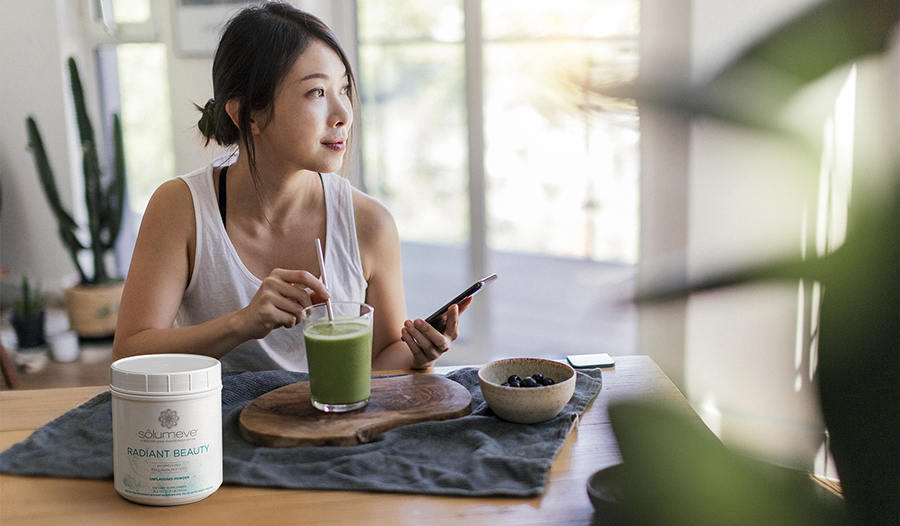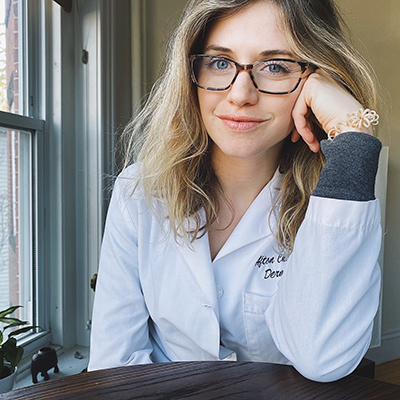A Dermatologist Breaks Down the Best Diet for Your Skin Type

You’ve heard it before–you are what you eat.
There’s no question that the calories and types of food we put into our bodies have an influence on our overall health and wellbeing, and these effects also translate to skin health. However, the extent to which different types of foods influence our skin is difficult to say with certainty. Let me explain.
You may have noticed there are lots of different opinions with respect to nutrition recommendations for skin health, and that’s because it’s difficult to systematically study these topics.
For example, the strongest level of scientific evidence that we can learn from are randomized, double-blinded, controlled studies. Unfortunately, performing randomized, controlled studies on the human diet is almost impossible because everyone eats differently. In addition, performing blinded studies in which the participants don’t know what they’re eating (which could influence how they perceive their outcomes) is also challenging because the consistency and taste of food make it possible for study participants to figure out what they are eating.
To do a study that achieves all these goals also costs a lot of money, and since “foods” won’t ultimately make money for a company (as opposed to studying a new medication that can be sold), there is less incentive for organizations to perform such studies.
I mention all of this because most of what we know about nutrition and the skin comes from studies that are less high-quality than what we would ideally like to have to make solid recommendations. Nevertheless, as a physician and dermatologist, I firmly believe that what we put in our body has an effect on our body and our skin, so I’ll share with you what we know so far.
Dietary Considerations for Acne-Prone Skin
The most frequently discussed foods that are rumored to trigger acne include chocolate, milk/dairy products, and foods that are high on the glycemic index.
Chocolate
Chocolate actually does not have any good evidence that it contributes to acne. Dark chocolate, which is high in cocoa and low in milk/sugar, actually contains antioxidants that may be good for your skin. I do wonder if chocolate gets a bad rep for causing acne because perhaps people eat it more during times of stress, or during hormonal variations that cause cravings, which actually can be the underlying trigger for breakouts.
Dairy
Cow’s milk, particularly skim milk, does seem to be implicated in contributing to acne, based on the available evidence. However, there is no evidence that yogurt or cheese can increase acne breakouts. My suggestion would be to limit cow’s milk and ice cream, particularly skim milk. These days, there are a number of alternative milk options such as soy, oat, almond, coconut, and hemp milk. All of these milks also have benefits and disadvantages, though, so best to keep things varied and in moderation.
High Glycemic Index Foods
Eating high glycemic index foods can trigger inflammation and sebum (oil) production in the body, worsening acne. When we talk about the glycemic index, we are referring to how quickly foods are broken down and used in the body. Foods that are high on the glycemic index are broken down rapidly and lead to high spikes of sugar and insulin, which are more harmful. Foods low on the glycemic index are broken down more slowly, resulting in a more gradual insulin response, which is better for the body. There are a number of great charts and resources that show where foods fall on the glycemic index. In general, white starchy, sugary, processed foods are high on the glycemic index and should be avoided.
Best Nutrition for Dry Skin
Most of us have dealt with dry skin at some point or another, but some people have it worse than others. People with sensitive skin or conditions like atopic dermatitis and other forms of eczema often have to deal with dry skin chronically. Dry skin can also be brought on by changes in the seasons (winter) and environment (arid climates). To prevent dry skin, you have to tackle two main components: skin hydration and the skin barrier.
Hydrate
The hydration part is pretty straightforward from a dietary perspective–stay hydrated! Drink plenty of water and electrolytes. You’ll have to drink even more water if you’re consuming fluids that have diuretic effects, such as coffee, tea, and alcohol.
Nourish the Skin Barrier
The skin barrier is made up of a waxy outer layer made of lipids (fats) such as ceramides and fatty acids. Often when we discuss skin barrier optimization, we talk about applying occlusive moisturizers to strengthen the barrier and prevent water loss from the skin.
To improve the skin barrier through diet, look for foods that are high in vitamin D and omega-3 fatty acids, such as fish (mackerel, wild salmon, herring, trout, and anchovies), egg yolks, nuts, and cod liver oil. Incorporating healthy oils into the diet such as extra virgin olive oil, avocado oil, walnut oil, and flaxseed oil can also be helpful.
Foods that are high in vitamin A may also be helpful in combating dry skin by enhancing skin renewal and decreasing flakiness. Some foods that are high in vitamin A include sweet potatoes, tomatoes, liver, and certain cheeses.
There is a lot more information I could share about the skin and other vitamins/minerals, such as vitamin C, vitamin E, zinc, copper, and silica; however, that is beyond the scope of this article. In general, I don’t recommend vitamin supplementation unless you know you truly have a vitamin deficiency. Sometimes vitamin supplementation runs the risk of having an opposite, pro-oxidative effect at higher doses.
The Anti-Aging Diet
To understand how to maximize your diet for anti-aging effects, you first have to understand what happens to the skin as we age.
As we go through life, our skin is exposed to UV light from the sun, pollution, and other stressors in the environment. This leads to oxidative stress and free radicals that cause inflammation and damage to cells and proteins in the skin. This repeated damage over time leads to loss of collagen (manifesting as wrinkles and loss of volume), changes in elastin (leading to dull/sallow skin tone and loose skin), and other changes in the fat and bone.
In addition, there is another process that speeds up aging, and that’s called glycation. Glycation occurs when glucose (sugar) from the diet gets added onto proteins, fats, and DNA, resulting in advanced glycation end products (AGEs) or glycotoxins. Glycation alters the structure of skin collagen and elastin and leads to more oxidative stress, resulting in skin aging referred to as the “sugar sag.” Glycation also has been implicated in cardiovascular disease, dementia, diabetes complications, and other diseases.
Minimize Sugar
So, how can your diet help fight skin aging? The first tip is to minimize sugar in your diet to help decrease glycation. Avoiding sugary desserts is one obvious way to do this, but I would also recommend choosing carbohydrates that break down more slowly in the body. To do this, look for complex carbohydrates and foods that are low on the glycemic index as I mentioned above. Examples of low glycemic index foods include green vegetables, fruits, chickpeas, lentils, and bran breakfast cereals. High glycemic index foods that should be eaten sparingly include foods like white rice, white bread, and potatoes. Meat products and high-fat cheeses can result in high dietary AGEs. Several studies have also shown that spices like cinnamon, garlic, rosemary, black pepper, and turmeric have anti-glycation properties, so these are great to add to your recipes as you’re cooking. Adding lemon juice and vinegar while cooking can also decrease the amount of AGEs produced.
Increase Antioxidants
My next tip is to eat healthy foods that are high in antioxidants, which is sometimes referred to as an anti-inflammatory diet. This can help fight the oxidative stress and inflammation that occurs during normal life. One of the diets with the best evidence is the Mediterranean diet, which is mostly plant-based and emphasizes healthy fats, whole grains, fruits, vegetables, beans, nuts, seeds, and seafood.
Fruits and vegetables often are chock-full of anti-inflammatory phytonutrients such as flavonoids and carotenoids. Turmeric, ginger, garlic, green teas, and black teas have potent antioxidant effects and can be great to incorporate into your diet. This probably goes without saying, but smoking and heavy drinking also are well-known to contribute to inflammation and skin aging, and minimizing these are crucial to a skin-healthy lifestyle.
Are you hungry yet? I hope this overview was beneficial in guiding your dietary choices in achieving a healthy glow. As with everything in life, it’s all about balance. If you have further questions about your skin or skin issues that don’t respond to a healthy diet and lifestyle, seek assistance from a board-certified dermatologist.
DISCLAIMER:This Wellness Hub does not intend to provide diagnosis...
















































































 Table of Contents
Table of Contents
















